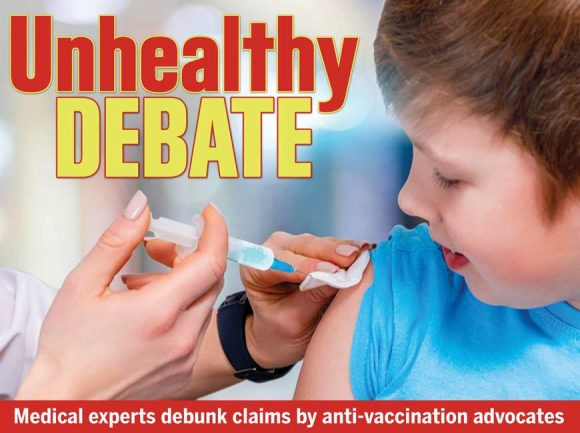Unhealthy debate: Medical experts debunk claims by anti-vaccination advocates

Education, litigation, big pharm, little children, doctors, disease, disability, death — the debate surrounding vaccination thrives at the intersection of some of the most contentious topics of the day.
It’s an emotional subject, to be sure, but it’s also one of the most rigorously vetted and empirically analyzed, owing to the scientific nature of medicine.
Some, however, still believe that vaccination is unsafe, unhealthy and unnecessary, right in the middle of the worst national measles outbreak in two decades.
Cloaked in problematic conclusions divined from discredited studies and debunked “experts,” anti-vaccination advocates implore the public to demand of vaccine manufacturers accountability, transparency and academic rigor — principles for which a recent presentation in Haywood County was sorely lacking.
Down with disease
The practice of vaccination is a relatively recent scientific development, with some of the first significant achievements taking place during the 1790s when English scientist Edward Jenner began transferring material from the cowpox wounds of one person to the arm of a different, healthy person.
Related Items
This deliberate introduction of disease — albeit, a weakened strain of it — provokes the body’s immune system to produce a variety of defenses against the full-strength disease itself. Of course, this does carry risk and can lead to illness or death, especially in patients with compromised immune systems.
As medical science advanced so did the study of vaccines, leading to the introduction of some of the first major vaccines in the early part of the 20th century, including pertussis in 1914, diphtheria in 1926 and tetanus in 1938. In 1948, these were combined into one, known as the DTP vaccine.
During the 1950s, every parent’s nightmare was polio, an infectious disease that can lead to paralysis. In 1955, Dr. Jonas Salk introduced his polio vaccine, which had an immediate and dramatic impact, slashing the number of annual U.S. polio diagnoses from more than 15,000 per year to about 10 per year in less than two decades.
“When I was a kid, when the polio vaccine came out, every parent wanted their kid to have that vaccine,” said Patrick Johnson, Haywood County’s director of public health. “Everybody feared polio. And when they came out with an Ebola vaccine in Africa, everybody’s going to want that vaccine, because they fear Ebola.”
Johnson’s been a public health nurse for more than 35 years, including 27 years in the United States Air Force, seven of which he served as an immunization officer.
During that time, those vaccines were administered to men, women and children, along with the next crop of vaccines that emerged in the late 1960s — measles (1963), mumps (1967) and rubella (1969) which were merged into MMR in 1971.
Throughout the 1970s, the only vaccines generally recommended were DTP, Polio and MMR.
The smallpox vaccine, which had been studied since the time of Edward Jenner, was actually removed from the list of recommended vaccines during the 1970s because successful administration of the vaccine in decades prior made the smallpox virus nearly extinct in the U.S.
Despite the success of these vaccines in promoting public health, by the early 1980s anecdotal reports of degenerative brain injury due to the pertussis component of the DTP vaccine began to arise and with them, lawsuits against vaccine manufacturers.
This forced some manufacturers to stop making the vaccine, made it difficult for other manufacturers to obtain liability insurance and drove up the price of the DTP vaccine for consumers, threatening the very existence of the industry as a whole.
There was, however, just one problem: the anecdotal reports of DPT’s dangers were just that — demonstrably false, unsubstantiated claims. The brain injuries reported were later traced to another medical condition altogether, infantile epilepsy.
That whole episode led to the creation of the National Childhood Vaccine Injury Act of 1986. Signed by President Ronald Reagan with bipartisan support, the Act prohibited lawsuits from being filed directly against manufacturers and instead directed them to what’s called the National Vaccine Injury Compensation Program (NVICP).
The Act also levied a 75-cent tax on all vaccines, which went into a fund used by the NVICP to pay out compensation claims when warranted.
Conspiracy theorists cite this event as a watershed moment in the anti-vaccination narrative by alleging improper government protectionism in the multi-billion dollar pharmaceutical industry, when in reality the Act was a direct response to unsubstantiated claims made in frivolous lawsuits.
Thus emboldened by the purportedly nefarious intent of the Act, the anti-vaccination movement would revel in yet another pyrrhic victory just a few years later.
In 1998, one of the world’s oldest weekly peer-reviewed medical journals, The Lancet, published a study that would come to be known as the Wakefield study.
Along with a dozen colleagues, British physician Dr. Andrew Wakefield authored a paper that suggested the MMR vaccine “may predispose to behavioral regression and pervasive developmental disorder in children,” according to the April 2011 issue of the Indian Journal of Psychology.
The study alarmed the medical community as well as the parents of young children, who reacted as most parents would — they stopped vaccinating their children.
There was, however, a problem with that, too: today, the Wakefield study is considered one of the greatest examples of medical fraud in history.
Scholars soon seized on Wakefield’s small sample size, poor experiment design and unsupported conclusions. Wakefield’s claims were completely refuted, 10 of the 12 authors retracted the study, and in 2010 The Lancet retracted the study altogether. That same year, Wakefield was stripped of his license to practice medicine.
It was later revealed that the Wakefield study was funded by attorneys who specialized in suing vaccine manufacturers, meaning Wakefield had engaged in deliberate fraud for financial gain.
“Scientists and organizations across the world spent a great deal of time and money refuting the results of a minor paper in The Lancet and exposing the scientific fraud that formed the basis of the paper,” concludes the Indian Journal of Psychology’s article. “Appallingly, parents across the world did not vaccinate their children out of fear of the risk of autism, thereby exposing their children to the risks of disease and the well-documented complications related thereto. Measles outbreaks in the UK in 2008 and 2009 as well as pockets of measles in the USA and Canada were attributed to the nonvaccination of children.”
The Indian Journal of Psychology article also admits — somewhat sheepishly — that it is a “matter of concern” that the exposé came as “a result of journalistic investigation, rather than academic vigilance followed by the institution of corrective measures.”
The journalist, Brian Deer of Britain’s Sunday Times, had also done earlier reporting on false allegations claiming a link between vaccines and autism.
If anything, both Deer and Wakefield reinforced the critical importance of the basic tenets of scientific inquiry — empirical investigation, theory-based research, clear methodology, rigorous logic, repeatability and transparency.
SEE CHART: N.C. vaccination rates by the numbers
‘Recording prohibited’
On Thursday, July 18, an informational event held by registered nurses Maureen McDonnell and Janet Presson at the county-owned Haywood County Public Library got off to an inauspicious start.
Titled “Vaccines: are they really safe and effective?” the event was advertised on Facebook as well as by paper handbills, and invited the public to “come get answers to all your questions about safety testing, side effects, efficacy, how vaccines are approved, immunity and product liability.” The flyer also advertised refreshments, handouts and door prizes to entice the public to attend.
Local mom Melanie Williams facilitated the event and its hour-long slide presentation, which she said would be informative in nature.
“I want to be very clear that this is not an anti-vaccine event. This is a vaccine education event, and I want that on the record. We’ve already had some trouble with misconstruction [sic] on that,” Williams said. “We do not claim or accept the title of anti-vaccine. This is about education and choice, so please make sure any reference you make to the event that you’re clear about that.”
At the commencement of the presentation, McDonnell told the audience that video or audio recording would not be allowed.
Kimberly King of Asheville’s WLOS-TV was present with a camera crew and voiced her displeasure, but McDonnell reiterated that she would not permit recordings because it was the first time they’d done such a presentation, and she didn’t feel it was “polished.”
WLOS then told McDonnell that they would call the county attorney, just as Williams’ husband, Chris, rose from the audience and stood in front of the WLOS camera, blocking the shot.
Reporting for The Smoky Mountain News, I told McConnell that I was not recording for broadcast purposes, only for accuracy, but was still denied permission. I questioned the logic of not creating a permanent record of the event to ensure clarity and told McConnell that this being a county-owned building, I would record anyway.
Eventually, someone — WLOS credits an unnamed library employee — told McDonnell to drop her objections to recording.
“Alright,” McDonnell said. “You do have a right to record, and we may not be as polished as we like but again, we are open to discussion afterwards if there’s questions you have.”
Turns out, whoever that person was, was right.
“Since the event was a public event, the recording of the voices and images of persons present at the event is governed by N.C. law, not any county ordinance,” said Haywood County Attorney Frank Queen. “In general, persons voluntarily present at a public event do not have a reasonable expectation of privacy at that public event, which makes the recording of their voices and images permissible. If a member of the public can be at an event, then a representative of the press can equally be there. If a member of the public could record the voice or images of persons present, then a representative of the press can likewise make such a recording.”
The presentation’s inauspicious start didn’t set well with the county’s public health director.
“Well that bothered me from the get-go,” said Johnson, who attended the event and as a vegetarian, a stroke survivor and a public health director has more than a passing interest in the academic integrity of a health care presentation. “Right away, I heard somebody say they were going to contact the county lawyer, so I figured immediately that would get reversed. I also thought if they didn’t want it recorded, they didn’t want the general public to know what they were going to be saying, so that concerned me.”
Logical fallacies
Johnson’s concerns over transparency were shown to be warranted once McDonnell, a pediatric registered nurse for 42 years who worked in labor and delivery, served as a national coordinator for the Defeat Autism Now! conferences and as the health editor of WNC Woman Magazine, began her 40-slide presentation.
“There’s a pattern to the anti-vax movement and to the arguments,” Johnson said the next day. “In retrospect, that was a very slick anti-vax presentation. They cherry-pick little things about vaccines for some misleading suppositions.”
Those misleading suppositions are based on misrepresentation of facts, errors of omission, dubious sourcing and improperly equating correlation with causation.
“In 1986 about 12.8 percent of our kids had chronic illness — asthma, allergies eczema,” McDonnell said at the outset. “They had to bus us 45 minutes to see one child with autism, to observe one child with autism, back then. We just had a very low percentage of kids with chronic illnesses back then as opposed to today, over half of our children have been diagnosed with these conditions — one or more chronic illnesses.”
Her slide said the number of kids with chronic illness today is 54 percent, but a 2017 report by the Centers for Disease Control and Prevention says that 85 percent of U.S. children aged 5 through 11 are in “excellent or very good health.”
Nevertheless, the “13 to 54 percent” figure would permeate the presentation, with McDonnell, Presson and Williams presenting vaccination as the only likely culprit.
That 1986 date figures prominently in the anti-vax narrative as well.
“In 1986 something interesting happened,” McDonnell said. “The vaccine industry went to Congress and they said, ‘You know what? We’re getting sued left and right, folks. You’ve got to help us here.’ It was mostly the DPT vaccine at that time that was problematic, and there were a lot of lawsuits and they said ‘Please, we’re going to get out of the business and stop making vaccines if you don’t help us.’”
McDonnell’s right — vaccine manufacturers were being sued “left and right.”
What she failed to mention was that they were being sued over unsubstantiated claims made in frivolous lawsuits that directly led to the creation of the National Childhood Vaccine Injury Act of 1986.
“They passed a law that said the vaccine industry is now no longer liable for any injury caused by vaccines,” said McDonnell. ‘It gave blanket immunity to vaccine manufacturers.”
Also somewhat true — except that the National Vaccine Injury Compensation Program that was created by the National Childhood Vaccine Injury Act of 1986 and is funded by a tax on vaccines does allow for compensation to bona fide victims of vaccine injury.
“So again, in 1986 we had about 13 percent of kids with chronic illnesses, and now we have a much higher percentage,” McDonnell said, strongly implying that the 1986 legislation was somehow responsible for the 54 percent figure that isn’t real in the first place.
“There is a very big push right now to convince all of us that vaccines are completely safe and they are completely effective,” she continued, neglecting to mention the voluminous documentation that comes with most medicines and vaccines today.
According to the FDA, the packaging insert included with the MMR vaccine provides almost a thousand words worth of warnings and precautions.
“Safety and effectiveness of measles vaccine in infants below the age of 6 months have not been established,” it reads. “Safety and effectiveness of mumps and rubella vaccine in infants less than 12 months of age have not been established …. As for any vaccine, vaccination with M-M-R II may not result in protection in 100% of vaccinees.“
Side effects listed on the insert include fever, headache, dizziness, malaise and irritability, along with other, more serious adverse reactions.
“Encephalitis and encephalopathy have been reported,” it says, “approximately once for every 3 million doses of M-M-R II or measles-, mumps-, and rubella-containing vaccine administered since licensure of these vaccines.”
McDonnell, aided by fellow nurse Presson, then presented a trio of video clips featuring discredited “experts” who project a veneer of authority but have been publicly admonished, ostracized or sanctioned by most of mainstream academia.
First was noted anti-vaccination advocate Del BigTree, a former film student and Dr. Phil show producer who in 2016 produced the movie “Vaxxed: From cover-up to catastrophe.” The film was directed by (former) doctor, Andrew Wakefield.
Next was Dr. Bob Sears, a California pediatrician whose license was revoked by the Medical Board of California in June 2018, for writing inappropriate vaccine exemptions, according to Forbes magazine. Sears’ revocation was stayed, pending 35 months of probation and adherence to sanctions including additional education and supervision by a physician with whom he has no prior relationship, but as also reported by Forbes a month ago, Sears had once again come under scrutiny for the same actions that got him in trouble in the first place.
Last but not least was Dr. Christopher Shaw, who narrated an animated sequence describing his study of adjuvants, specifically aluminum, in mice. Adjuvants are additives in vaccines that help the active ingredient linger longer in the human body, producing better results with lower dosages of the active ingredient, which is, again, a disease that brings with it a small risk.
In 2011, Shaw published two reports claiming his mice exhibited clear degradation in behavior, cognition and motor function after the subcutaneous injection of aluminum.
“Once we sacrificed the animals and started looking inside their brains and spinal cords, we found massive damage to motor neurons, and so we may be creating the conditions for Parkinson’s disease, Lou Gehrig’s disease, Alzheimer’s disease. Maybe not immediately,” says Shaw in the video, “but maybe 20, 30, 40 years down the road. We had some concerns when we released the study that it might trigger a bit of a backlash. It actually triggered a lot of silence.”
None of that is true. The World Health Organization quickly called the reports “seriously flawed,” and as in the case of Wakefield, it was later revealed that Shaw had accepted funding — to the tune of $900,000 — from interest groups with anti-vax agendas. As recently as 2017, Shaw has retracted papers claiming that aluminum adjuvants caused symptoms “consistent with those in autism” in mice, according to well-known tech blog Ars Technica.
McDonnell continued the presentation by re-presenting the “13 to 54” percentage with a slightly different, albeit similarly flawed approach.
“Autism, when I was in nursing school, it was 2 per 10,000,” she said. “Now it’s about 1 in 59 according to the CDC.”
One of the very first studies on autism — from Britain, involving children born in 1970 who were tested at the age of five — suggested an autism incidence rate of 4.5 per 10,000, but a 2001 study published by the British Medical Journal reexamined those results with modern criteria. When they did, they found the rate closer 37.6 per 10,000.
McDonnell’s 1 in 59 rate translates to about 170 in 10,000— an increase nonetheless, but not quite as dramatic as portrayed.
Dr. Stephen Wall, a Haywood County pediatrician for 30 years, thinks this is because of both changes in diagnostic approaches as well as increasing exposure to toxic substances.
“I think the diagnoses have greatly expanded, but we have to wonder what people are exposed to — plastics, chemicals pesticides,” said Wall. “In San Francisco they did an analysis of cord blood. They found 200 different chemicals from industry and agriculture that are not normally present in the placenta. So we don’t really know the effect of all this stuff.”
But do vaccines cause or contribute to the rise in autism diagnoses?
“Absolutely not. That’s been totally disproven,” Wall said. “Millions and millions of dollars and hundreds and hundreds of scientific hours have been spent exposing this. It started in England with Wakefield. He was banned from practicing medicine and his article was withdrawn from a British medical journal. This has all been shown to be bogus, and he has made a great name for himself promoting fear.”
Patrick Johnson had raised his hand a number of times during the presentation despite direction from McDonnell to save all questions for the end.
“Number one, I was bothered that they wouldn’t let me respond. Almost every slide, I was raising my hand because I felt like there was misinformation on virtually every slide,” he told The Smoky Mountain News the next day, adding that he felt the entire presentation was nonscientific.
At the end of the 75-minute presentation, Johnson finally got his chance to address McDonnell, Presson and Williams.
“I did Google anti-vax arguments,” Johnson told Williams. “What we’ve heard here tonight were the typical anti-vaccine arguments.”
McDonnell, though, called it a “healthy debate.”
“We’re not anti-vax, we’re pro-children’s health, we’re pro-vaccine education,” she said. “You can go around and call us what you’d like, but this anti-vax thing is silly, and it shuts down discussion, and discourse, and I believe that strongly. None of us are anti-vaccine, we’re pro-vaccine safety, pro-vaccine education.”
Johnson briefly sparred with the presenters over thimerisol, a mercury-based preservative they correctly pointed out is an ingredient in a very limited number of vaccines but failed to note was also the subject of reporting by Sunday Times journalist Brian Deer, prior to his blowing the whistle on Wakefield.
Deer’s reporting helped debunk claims of connections between mercury-based preservatives, like thimerisol, and autism spectrum disorders.
Presson, an Air Force veteran, still blames mercury for her son’s developmental disability.
“Squeaky-clean lifestyle, no drugs, no alcohol, but we [her and her husband] were both fully immunized for worldwide deployability, which may have triggered something,” she said. “He was doing great, meeting all his milestones. We both had master’s degrees, so we were well-educated parents, and everything was fine, everything was on schedule until he got his shots at 15 months. He stopped talking, stopped looking us in the eyes, and never met his milestones again.”
Mountaineer reporter Kyle Perotti asked Presson how she could tell that it was the vaccines that caused the injury.
“There is now lab work you can do with physicians who understand how to read it, and there is a network of these around the country now, and we’ve got one of those that has done the lab work,” she said. “He said ‘Yeah, [your son] is full of mercury.’ He was loaded with mercury, so where else did he get the mercury?”
During the exchange, Johnson even admitted the undisputed fact that vaccines are not 100 percent effective, only to be met with more misinformation from Williams.
“The flu vaccine had a 1 percent effective rate last year,” she told Johnson.
“That’s not so,” he said. “I think it was more like 45 percent effective.”
Data from the CDC says that for the 2018-19 flu season, effectiveness of vaccines for influenza A or B across all ages was 47 percent; for influenza A (H1N1), it was 46 percent for all ages. In both cases, the effectiveness was about 60 percent for a particularly vulnerable population — those aged 6 to 17 months. For the H3N2 strain across all ages, effectiveness was measured at 44 percent.
The three R’s: reading, writing and … rubella?
Despite Williams’ claims to disavow the anti-vax label, her personal Facebook profile shows she shared an image from a group called “California Anti-Vax Mommies” on April 30 that derided parents of children suffering from measles.
“We do not have a measles epidemic,” it reads. “We have an epidemic of parents who don’t know how to care for a child that has a rash and a cold for a week.”
While the CDC won’t call it an “epidemic,” it does call the thousand-plus measles cases diagnosed in the U.S. so far this year an “outbreak,” which is accurate considering the CDC declared measles “eliminated” in 2000 when only 86 cases were diagnosed across the nation.
Measles “is not a mild disease,” according to Johnson.
“People can become deaf from measles,” he said. “They can have encephalitis from measles and they can die from measles. It’s nothing you want your child to go through.”
Somebody with measles, Johnson said, is contagious two weeks before they show signs of the condition, but students in many states, including North Carolina, can be granted exemptions from required vaccines for medical reasons, or for religious reasons.
“In our schools, we know that there are ‘x’ amount of children who are not vaccinated, and a few of them are immune-compromised, and they could be exposed to a child with measles, so it’s not an innocent type of thing,” he said (see By the numbers, page 6). “Pregnant women should not get measles. We definitely don’t want it to be spreading.”
The State of New York recently did away with the religious exemption — a severe reaction to the rash of cases they’d been experiencing — but closer to home, Haywood County Schools introduced a precautionary statement to parents in June.
“If there is a case of measles in your school, they’re going to pull each child who is not vaccinated from the schools for 21 days,” said Johnson. “It’s considered a best practice by the CDC.”
The Jackson County Department of Public Health issued a similar statement in May.
Johnson opined that if more and more parents stop vaccinating their children, the consequences wouldn’t be pleasant.
“The diseases would come back. It wouldn’t take too long, but the diseases would slowly start to come back,” he said. “When there was a concern about pertussis in Japan in the 1970s and [the concerns] spread across the population and people stopped getting vaccinated, about three years later there was an outbreak – about 36 deaths.”
The CDC actually reports 41 deaths during the 1979 Japanese pertussis outbreak, but amidst all the other misinformation presented at the event, Johnson still believes his time — on behalf of the citizens of Haywood County — was well spent.
“I’m glad I went,” he said. “I never thought I would go to an anti-vax meeting in Haywood County, of all places. I feel bad that somebody has an autistic child, and I’m really surprised that in this day and age people still connect it with MMR. There is a ton of research to show that MMR is not the cause of autism.”
McDonnell, Presson and Williams challenged Johnson to a formal debate or panel discussion, but given the unwavering appeal to discredited so-called experts and studies, Johnson isn’t sure it would do much good.
“I will only do it if I’m joined by a pediatrician,” he said. When asked if he’d join Johnson, Dr. Wall said, “Possibly.”









